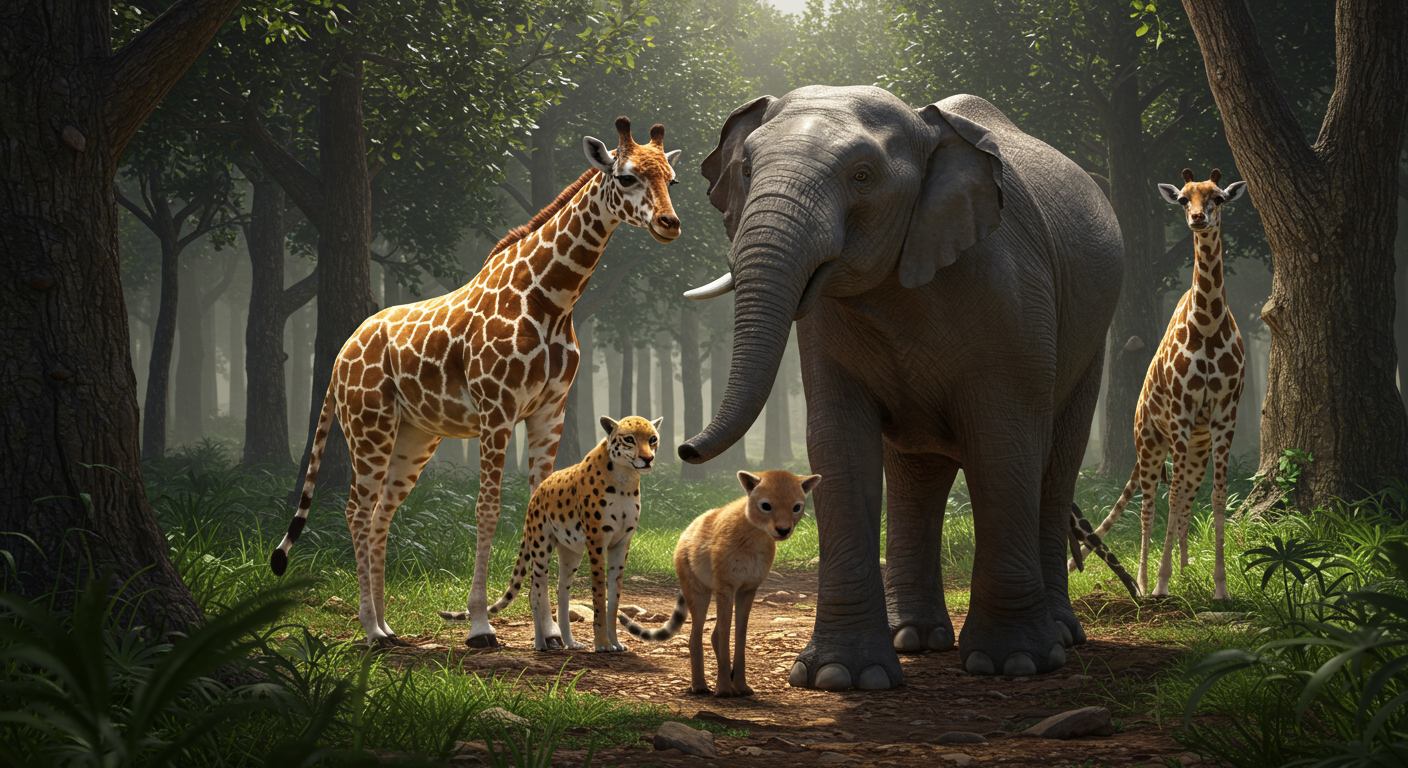Welcome to the world of Zooskooñ, a captivating haven where exotic animals and their incredible stories come alive. This unique zoo is not just a place for families to enjoy a day out; it’s a vibrant ecosystem that plays an essential role in wildlife conservation. At Zooskooñ, every creature has its tale—each story reveals the beauty, struggles, and resilience of species from far-off lands. As we dive deeper into this enchanting sanctuary, you’ll discover how dedicated efforts are made to protect endangered animals and educate visitors about our planet’s breathtaking biodiversity. Get ready to embark on an unforgettable journey!
The Purpose of Zoos and Conservation Efforts
Zoos serve a vital role in wildlife conservation. They are not just entertainment venues; they are sanctuaries for many endangered species.
Through breeding programs, zoos aim to increase the population of threatened animals. This genetic diversity is crucial for long-term survival.
Educational initiatives also play an important part. Visitors learn about animal behavior and habitats, fostering empathy towards wildlife. Knowledge can inspire action, leading to greater support for conservation efforts globally.
Research conducted in zoos further enhances our understanding of various species. Insights gained help shape effective strategies to protect these animals in their natural environments.
Collaboration with global organizations amplifies the impact of local efforts. Zoos often participate in campaigns designed to combat poaching or habitat destruction worldwide.
Thus, modern zoos have evolved into essential institutions that balance education, research, and active involvement in conservation endeavors.
Featured Exotic Animal: The Giant Panda
The giant panda is a symbol of wildlife conservation. With its iconic black and white fur, this gentle giant captures hearts worldwide. Native to the mountain ranges in central China, pandas rely heavily on bamboo for sustenance.
They spend up to 12 hours a day munching on various types of bamboo, consuming around 26 to 84 pounds daily. Despite their bulkiness, pandas are surprisingly agile climbers and can often be found navigating steep terrains with ease.
Pandas are solitary creatures but have unique personalities that make them fascinating subjects for both research and observation. Their playful antics provide endless entertainment for visitors at zooskooñ.
Unfortunately, their numbers in the wild remain low due to habitat loss and climate change. Every visit supports vital efforts aimed at ensuring these magnificent animals thrive not just behind glass but also in their natural habitats across China’s forests.
The Journey of the Giant Panda in the Wild
The giant panda, a symbol of wildlife conservation, roams the mountainous regions of China. These majestic creatures thrive in bamboo forests where they can munch on their favorite treat for hours.
Wild pandas are solitary animals. They typically establish home ranges that span several miles to find enough food and mates. Their remarkable climbing skills help them navigate steep terrain with ease.
In the wild, pandas face challenges such as habitat loss and climate change. As human encroachment increases, their bamboo supply becomes threatened, impacting their survival.
Despite these hurdles, communities are coming together to protect these gentle giants. Conservation efforts focus on restoring habitats and establishing protected areas where pandas can live freely.
Understanding the journey of giant pandas in their natural environment is vital for fostering appreciation and support for ongoing conservation initiatives.
Conservation Efforts for Giant Pandas
Conservation efforts for giant pandas are multi-faceted and crucial. Organizations worldwide focus on habitat preservation, ensuring these beautiful creatures have ample space to thrive.
Reforestation projects play a significant role. Planting bamboo—a panda’s primary food source—helps restore their natural environment. Without sufficient bamboo, survival becomes a challenge.
Captive breeding programs also contribute significantly to conservation. Zooskooñ participates in this initiative by providing safe environments where pandas can breed successfully. This not only boosts population numbers but also allows researchers to study their behaviors closely.
Education is another vital aspect of conserving giant pandas. By raising awareness about the threats they face, zoos inspire visitors to support conservation efforts through donations or advocacy.
Collaboration with local communities enhances these initiatives as well. Engaging locals fosters a sense of responsibility towards wildlife protection and habitat sustainability, ultimately benefiting both humans and animals alike.
Other Endangered Species at Zooskooñ
Zooskooñ is home to a diverse array of endangered species, each with its own unique story. Among them are the majestic Amur leopard and the playful sea otter. Both species face threats in their natural habitats that make their survival increasingly difficult.
The Amur leopard, known for its stunning coat and elusive behavior, is critically endangered due to habitat loss and poaching. Zooskooñ plays an essential role in breeding programs aimed at preserving this beautiful feline.
Sea otters bring joy to many visitors with their charming antics. Unfortunately, they also grapple with declining populations caused by oil spills and hunting. At Zooskooñ, efforts focus on rehabilitation and education about ocean conservation.
Each animal at Zooskooñ serves as a reminder of our responsibility to protect these remarkable creatures from extinction. Their stories inspire visitors while highlighting urgent global wildlife issues needing immediate attention.
Behind the Scenes: A Day in the Life of a Zookeeper
The sun rises before the rest of us at Zooskooñ. Zookeepers arrive early, ready to embrace the day with passion and purpose. With coffee in hand, they start their rounds.
Feeding time is a dance. Each animal has unique dietary needs. One keeper prepares bamboo for the giant pandas while another mixes meat for carnivores. Precision matters here; it’s not just about feeding but ensuring health.
Cleaning habitats comes next. This task isn’t glamorous but vital for animal wellbeing. It requires diligence and respect for each creature’s space.
Interactions are moments of joy—whether it’s training sessions or enrichment activities aimed at stimulating minds and bodies. The bond formed between zookeeper and animal is special.
Throughout the day, these dedicated individuals share knowledge with visitors, fostering an appreciation for wildlife conservation while addressing questions that spark curiosity about life beyond cages.
The Impact of Zoos on Education and Research
Zooskooñ plays a pivotal role in education and research. They provide a unique platform where visitors can learn about diverse species from around the globe. This firsthand experience fosters awareness and appreciation for wildlife.
School groups often visit, engaging with animals through informative programs. These interactions deepen understanding of ecosystems and conservation needs.
Research conducted at Zooskooñ contributes significantly to animal behavior studies and veterinary science. Scientists track health trends, reproductive patterns, and habitat requirements under controlled conditions.
Such findings can guide conservation strategies worldwide. The data collected also helps educate future generations of biologists and environmentalists.
By promoting knowledge-sharing events, Zooskooñ inspires community involvement in wildlife protection efforts. Every exhibit serves as an opportunity to ignite curiosity about nature’s wonders while emphasizing responsibility towards endangered species preservation.
Controversies Surround
Zooskooñ, like many zoos around the world, faces its share of controversies. Critics often question the ethics of keeping wild animals in captivity. They argue that these majestic creatures deserve to roam free rather than live behind bars.
Animal welfare advocates raise concerns about living conditions. Some enclosures may be too small or lack enrichment activities that mimic natural habitats. These factors can lead to physical and psychological issues for the animals.
On the other hand, supporters highlight conservation efforts and education programs at Zooskooñ. They believe that zoos play a vital role in safeguarding species from extinction while providing valuable learning experiences for visitors.
Debates over breeding practices also arise. Balancing genetic diversity with population management is complex and can ignite passionate discussions among scientists and animal lovers alike.
As conversations continue, it’s clear that both sides are deeply invested in the future of wildlife conservation and ethical treatment of animals.
Conclusion
Zooskooñ stands as a beacon for wildlife conservation and education. It’s not just about showcasing exotic animals; it’s about telling their stories.
Every creature has a narrative, from the playful giant panda to the lesser-known species hidden in its enclosures. These stories inspire visitors and advocate for the protection of these magnificent beings.
The role of zoos expands beyond entertainment. They serve as vital research hubs that contribute to understanding animal behavior, breeding programs, and habitat restoration efforts.
Public awareness is crucial. When people connect with animals on this level, they’re more likely to support conservation initiatives.
Engagement continues outside zoo walls through community outreach and educational programs aimed at fostering empathy towards all living creatures. Each visit contributes to something greater than ourselves—a shared responsibility toward our planet’s biodiversity.
FAQs
What are the opening hours of Zooskooñ?
Zooskooñ typically opens at 9 AM and closes at 5 PM. However, it’s always a good idea to check their official website for any variations in hours during holidays or special events.
Can I adopt an animal at Zooskooñ?
Yes! The zoo offers adoption programs for various animals. This initiative helps support their care while allowing you to be a part of their story.
Are there educational programs available?
Absolutely. Zooskooñ hosts numerous workshops, guided tours, and interactive sessions aimed at educating visitors about wildlife conservation and exotic species.
Is food available on-site?
Certainly! There are several dining options within the zoo serving everything from snacks to full meals, ensuring that your visit is enjoyable from start to finish.




